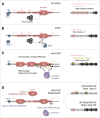Transcriptional reprogramming in cellular quiescence
- PMID: 28497998
- PMCID: PMC5546717
- DOI: 10.1080/15476286.2017.1327510
Transcriptional reprogramming in cellular quiescence
Abstract
Most cells in nature are not actively dividing, yet are able to return to the cell cycle given the appropriate environmental signals. There is now ample evidence that quiescent G0 cells are not shut-down but still metabolically and transcriptionally active. Quiescent cells must maintain a basal transcriptional capacity to maintain transcripts and proteins necessary for survival. This implies a tight control over RNA polymerases: RNA pol II for mRNA transcription during G0, but especially RNA pol I and RNA pol III to maintain an appropriate level of structural RNAs, raising the possibility that specific transcriptional control mechanisms evolved in quiescent cells. In accordance with this, we recently discovered that RNA interference is necessary to control RNA polymerase I transcription during G0. While this mini-review focuses on yeast model organisms (Saccharomyces cerevisiae and Schizosaccharomyces pombe), parallels are drawn to other eukaryotes and mammalian systems, in particular stem cells.
Keywords: Dicer; G0; RNA interference; differentiation; dormancy; epigenetics; histone; quiescence; reprogramming; stem cells; transcription.
Figures


Similar articles
-
RNA interference is essential for cellular quiescence.Science. 2016 Nov 11;354(6313):aah5651. doi: 10.1126/science.aah5651. Epub 2016 Oct 13. Science. 2016. PMID: 27738016 Free PMC article.
-
Asymmetric cell division requires specific mechanisms for adjusting global transcription.Nucleic Acids Res. 2017 Dec 1;45(21):12401-12412. doi: 10.1093/nar/gkx974. Nucleic Acids Res. 2017. PMID: 29069448 Free PMC article.
-
RNA-interference-directed chromatin modification coupled to RNA polymerase II transcription.Nature. 2005 Jun 30;435(7046):1275-9. doi: 10.1038/nature03652. Epub 2005 Jun 19. Nature. 2005. Retraction in: Nature. 2005 Oct 13;437(7061):1057. doi: 10.1038/nature04181. PMID: 15965464 Retracted.
-
RNA Pol IV and V in gene silencing: Rebel polymerases evolving away from Pol II's rules.Curr Opin Plant Biol. 2015 Oct;27:154-64. doi: 10.1016/j.pbi.2015.07.005. Epub 2015 Sep 5. Curr Opin Plant Biol. 2015. PMID: 26344361 Free PMC article. Review.
-
Dormancy and quiescence of skeletal muscle stem cells.Results Probl Cell Differ. 2015;56:215-35. doi: 10.1007/978-3-662-44608-9_10. Results Probl Cell Differ. 2015. PMID: 25344673 Review.
Cited by
-
Cellular quiescence in budding yeast.Yeast. 2021 Jan;38(1):12-29. doi: 10.1002/yea.3545. Epub 2021 Jan 25. Yeast. 2021. PMID: 33350503 Free PMC article. Review.
-
Quiescence, an individual journey.Curr Genet. 2019 Jun;65(3):695-699. doi: 10.1007/s00294-018-00928-w. Epub 2019 Jan 16. Curr Genet. 2019. PMID: 30649583 Review.
-
Role of Senescence and Aging in SARS-CoV-2 Infection and COVID-19 Disease.Cells. 2021 Nov 30;10(12):3367. doi: 10.3390/cells10123367. Cells. 2021. PMID: 34943875 Free PMC article. Review.
-
The fission yeast ortholog of Coilin, Mug174, forms Cajal body-like nuclear condensates and is essential for cellular quiescence.Nucleic Acids Res. 2024 Aug 27;52(15):9174-9192. doi: 10.1093/nar/gkae463. Nucleic Acids Res. 2024. PMID: 38828770 Free PMC article.
-
Mechanisms that Link Chronological Aging to Cellular Quiescence in Budding Yeast.Int J Mol Sci. 2020 Jul 2;21(13):4717. doi: 10.3390/ijms21134717. Int J Mol Sci. 2020. PMID: 32630624 Free PMC article. Review.
References
-
- Lewis DL, Gattie DK. The ecology of quiescent microbes. ASM News 1991; 57:27-32
-
- Finkel SE. Long-term survival during stationary phase: evolution and the GASP phenotype. Nat Rev Microbiol 2006; 4:113-20; PMID:16415927; https://dx.doi.org/10.1038/nrmicro1340 - DOI - PubMed
-
- Rittershaus ES, Baek SH, Sassetti CM. The normalcy of dormancy: common themes in microbial quiescence. Cell Host Microbe 2013; 13:643-51; PMID:23768489; https://dx.doi.org/10.1016/j.chom.2013.05.012 - DOI - PMC - PubMed
-
- Xu HS, Roberts N, Singleton FL, Attwell RW, Grimes DJ, Colwell RR. Survival and viability of nonculturable Escherichia coli and Vibrio cholerae in the estuarine and marine environment. Microb Ecol 1982; 8:313-23; PMID:24226049; https://dx.doi.org/10.1007/BF02010671 - DOI - PubMed
Publication types
MeSH terms
Substances
Grants and funding
LinkOut - more resources
Full Text Sources
Other Literature Sources
Molecular Biology Databases
